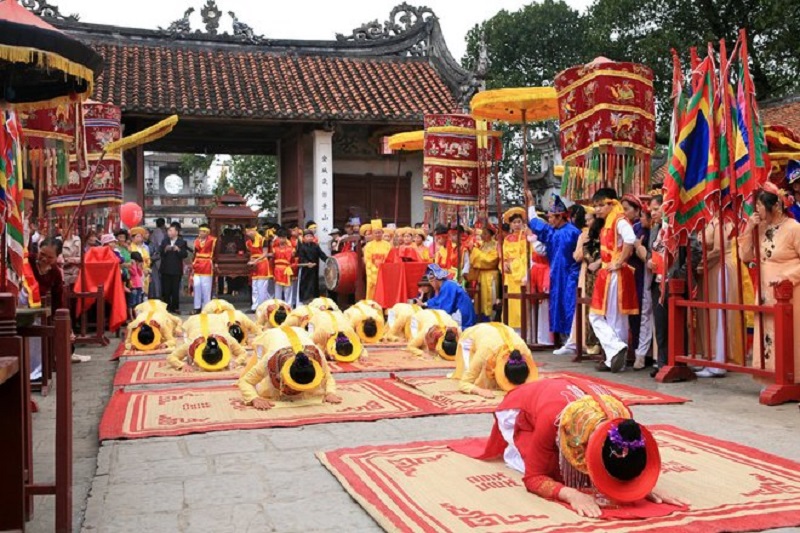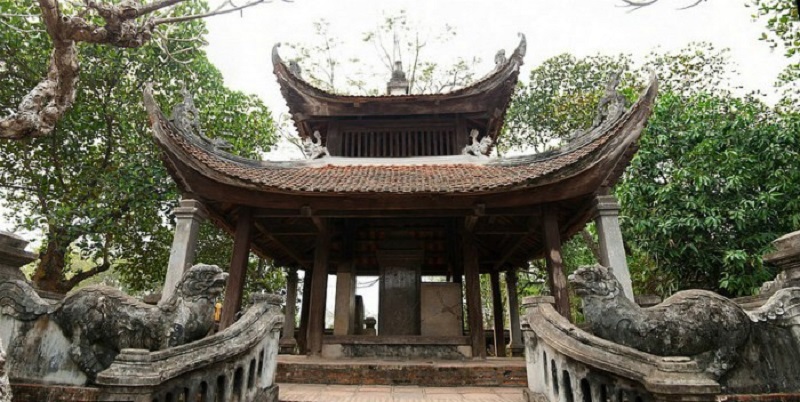King Ngo Quyen played a significant role in liberating Vietnam from over a thousand years of Chinese domination. His ascent to the throne followed a decisive victory against the Han invaders on Bach Dang River in 938.
Co Loa Citadel, located in Vietnam, holds historical significance as it was once chosen by an esteemed leader to be the country’s capital. The individual deserving of worship in a temple at this site is no longer widely remembered and evidence of their rule at Co Loa Citadel has become scarce.
 Co Loa Ancient CitadelLocated in Dong Anh district, Hanoi, the Co Loa Ancient Citadel is a historical site of great significance. Dating back to the 3rd century BC, it is considered one of the oldest citadels in Vietnam. |
There are currently 48 designated locations in our country where temples and shrines have been established to honor King Ngo Quyen. Specifically, in Hai Phong, where the famous and decisive battle on Bach Dang River against the Han invaders took place, the local community has built and maintained a noteworthy 36 temples and shrines dedicated to King Ngo Quyen. These places of worship continue to serve as a lasting tribute to his heroic legacy.
Currently, there is no established temple at Co Loa Citadel, which was selected by King Ngo Quyen as the capital of the country following his significant triumph over the Han invaders.
Recently, the Party General Secretary and State President, Nguyen Phu Trong, along with the esteemed members of the Politburo, have given their endorsement to the 17th Ha Noi Party Congress plan. During this event, the Party General Secretary emphasized the significant historical importance of Co Loa Citadel as an ancient capital that has left an enduring imprint on the nation’s history.
|
Co Loa Citadel is a historical site that holds significant importance in Vietnam’s history. It was chosen by King Ngo Quyen as the capital of the country after his successful triumph over the Han invaders. This citadel is a symbol of bravery and patriotism in Vietnamese culture. Capture the spirit of history at Co Loa Citadel. Photo credit: Hanoitravel.org. |
I believe that he had valid reasons for mentioning Co Loa Citadel, despite the fact that most people typically only reference Thang Long and Dong Do when discussing Hanoi’s thousand-year historical heritage.
In the opening remarks of his September 9 speech, Trong highlighted the significant growth of Ha Noi over the years. He pointed out that the city no longer consisted of only 36 streets and Co Loa Citadel, but had expanded its scale to a much larger extent.
“The status of our country has reached unprecedented heights, and the same can be said for Hanoi,” he said.
Hanoi is a city with a rich history, steeped in culture and boasting a glorious revolutionary tradition. It represents the cultural and heroic traditions, as well as the ideals of peace and friendship, of our nation.
In the following passage, Trong stated that Hanoi has a thousand-year history, an enduring culture, and an illustrious revolutionary tradition, serving as a symbol of the nation’s cultural heritage, heroism, and values of peace and friendship.
| Co Loa Festival takes place after Vietnamese traditional Lunar New Year/ Photo: Hanoitravel/org |
Hanoi is a city rich in history, embodying the thousand-year legacy of our heroic nation. It is believed that the poignant landmarks of Co Loa, Dong Do, and Thang Long symbolize the enduring impact of time on our mountains and rivers. Hanoi holds a sacred place in our hearts, radiating splendor and inspiring faith and hope.
I believe he possesses a deep understanding and appreciation for Hanoi, as he skillfully articulates its subtleties and depth through his words.
At a recent seminar organized by the Ha Noi Centre for Learning and Developing the Capital, participants were given insight into the restoration of the Lien Chau crossbow from King An Duong Vuong’s reign. This remarkable crossbow, along with its iconic arrow named Co Loa, was successfully restored and fired by engineer Vu Dinh Thanh, who currently works at a renowned weapons corporation in Russia. This achievement has shed light on the mysterious and authentic nature of the Lien Chau crossbow.
The authenticity of “the magic crossbow” legend, as well as the existence of the An Duong Vuong dynasty and Au Lac State, have been conclusively confirmed in our national history.
| Co Loa ancient citadel’s architecture/ Photo: Hanoitravel.org |
Co Loa, under the reign of King An Duong Vuong in the 3rd century BC, served as the capital of the Au Lac State. Situated approximately 20km north of Ha Noi, Co Loa Citadel holds historical significance. According to folklore, King An Duong Vuong successfully defeated the final Hung king in 257BC and proceeded to establish the Au Lac State, designating Co Loa as its capital.
The Co Loa Citadel holds the distinction of being the oldest and most expansive building in Vietnam, boasting a rich history that spans centuries. Its name, “Co Loa,” derives from the Sino-Vietnamese term for “old spiral,” referencing the unique spiral shape of its structure.







